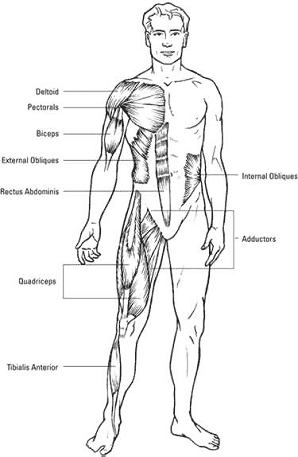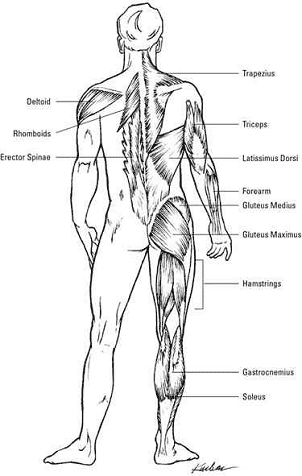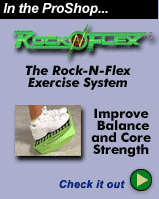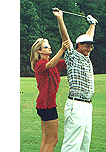
|
| |
|
|
| |
The
Strong Golf Body
Strength for Your Game
 Like
all athletes in the top level of sports, professional golfers
make the game look easy. Their swings seem as fluid and effortless
as running water, and they look as though they are on a leisurely
stroll as they pound drives more than 300 yards and hit high
soft iron shots. The truth is, professionals like Tiger Woods,
David Duval, Sergio Garcia, and Ernie Els as well as professionals,
such as Loren Roberts, Greg Norman, and Larry Nelson make the
game look easy, not because they aren’t exerting themselves,
but because they’re strong and fit enough to make a complicated
athletic move (the golf swing) look simple. Like
all athletes in the top level of sports, professional golfers
make the game look easy. Their swings seem as fluid and effortless
as running water, and they look as though they are on a leisurely
stroll as they pound drives more than 300 yards and hit high
soft iron shots. The truth is, professionals like Tiger Woods,
David Duval, Sergio Garcia, and Ernie Els as well as professionals,
such as Loren Roberts, Greg Norman, and Larry Nelson make the
game look easy, not because they aren’t exerting themselves,
but because they’re strong and fit enough to make a complicated
athletic move (the golf swing) look simple.
 Very
few amateurs can devote that amount of time, energy, and money
to their golf games, but that shouldn’t stop those amateurs
from making positive changes in their games by improving their
strength and conditioning. Over the years conditioning for athletes
has become an exact science. The workout regimen for basketball
teams isn’t the same as the program designed for swimmers,
football players, or tennis stars. Each sport requires certain
physical skills. Trainers must develop programs that enhance
the specific skills needed for a particular sport. Very
few amateurs can devote that amount of time, energy, and money
to their golf games, but that shouldn’t stop those amateurs
from making positive changes in their games by improving their
strength and conditioning. Over the years conditioning for athletes
has become an exact science. The workout regimen for basketball
teams isn’t the same as the program designed for swimmers,
football players, or tennis stars. Each sport requires certain
physical skills. Trainers must develop programs that enhance
the specific skills needed for a particular sport.
Golf is
no different. Even with the advancements in equipment and course
conditioning, golf is still a game of balance, discipline, and
touch. Enhancing and improving those specific skills requires
a balanced regimen with four equally important components: strength,
flexibility, endurance, and diet.
 Not
that long ago many people commonly assumed that strong muscles
were slow muscles, and anyone who worked out with weights ran
the risk of becoming a muscle-bound brute incapable of swinging
a golf club or having the delicate touch necessary for short chips,
pitches, and putts. Big, strong muscles were bad in golf, or so
said the conventional wisdom. Not
that long ago many people commonly assumed that strong muscles
were slow muscles, and anyone who worked out with weights ran
the risk of becoming a muscle-bound brute incapable of swinging
a golf club or having the delicate touch necessary for short chips,
pitches, and putts. Big, strong muscles were bad in golf, or so
said the conventional wisdom.
Even in the days when this thinking was prevalent, there were
exceptions. Because the in-club gym idea hadn’t caught on
in country clubs in the 50s and 60s, Gary Player and his friend
and workout partner, amateur Frank Stranahan carried their own
free weights with them on tour, much to the chagrin of their fellow
tour players. But while others sat in the clubhouse bars and scoffed,
Player won eight major championships, while Stranahan became the
top amateur golfer in the nation and regularly beat the world’s
best professionals in head-to-head competition. Today the value
of strength in golf is almost universally recognized. Strength
in all major and minor muscle groups plays a critical role in
the golf swing:
-
Strong
abdominals and external obliques (the trunk muscles along
your sides where “love handles” normally develop)
are essential for good posture at address. This becomes especially
critical for golfers with the increased risk of back and neck
injury resulting from poor posture.
-
Shoulder,
arm, and upper back strength are crucial in the takeaway,
the downswing, the follow-through, and the short game. Your
swing is initiated with the shoulders and hips rotating away
from the target. The pectoralis major (the chest muscles)
aids in moving the target arm away from the target. The forearms
and wrist engage to keep the club in a cocked position. The
triceps extend to keep the target arm straight, while the
biceps flex the opposite or non-target arm. The rotator cuff
muscles work to stabilize the shoulder girdle and turn with
the shoulders and arms. The rotator cuff of the non-target
arm pulls the club back and externally rotates the arm. The
hamstrings and external obliques assist hip rotation during
the backswing, creating a stable stance and good posture.
The weight shifts from an almost equal distribution at address
to upwards of 85 percent on the rear foot due to the redistribution
of the upper body.
-
The
lower back is a source of much pain and misery in many golfers.
The coiling of the upper body around a resistant lower body
coupled with the twisting of the back during the downswing
and follow-through can have devastating results. Even in a
properly executed golf swing, back muscles pull at the lumbar,
and, if a golfer isn’t strong, the discs are susceptible
to strain and injury. Nothing can guarantee that you won’t
have back problems, even if you do everything right, but a
strong lower back is less likely to become an injured lower
back.
-
Strength
in the legs and hips are also crucial. Strong hamstrings provide
a solid base at address while the adductors (inner thighs)
and hip flexors initiate both the backswing and the downswing.
The gastrocnuemius, commonly called the calf muscle, drives
the lower body through the swing, while the ankle flexors
are critical for balance.
Click
here to find out your current level of fitness and how
much you should exercise based on your results.
A
professional trainer will help you get faster results and really motivate
you to stay on your program. You can
locate a golf-fitness trainer near you.
|
|
|
|



See Your Ad
Here!
Great traffic, great rates.
Email us for more
information.
|







